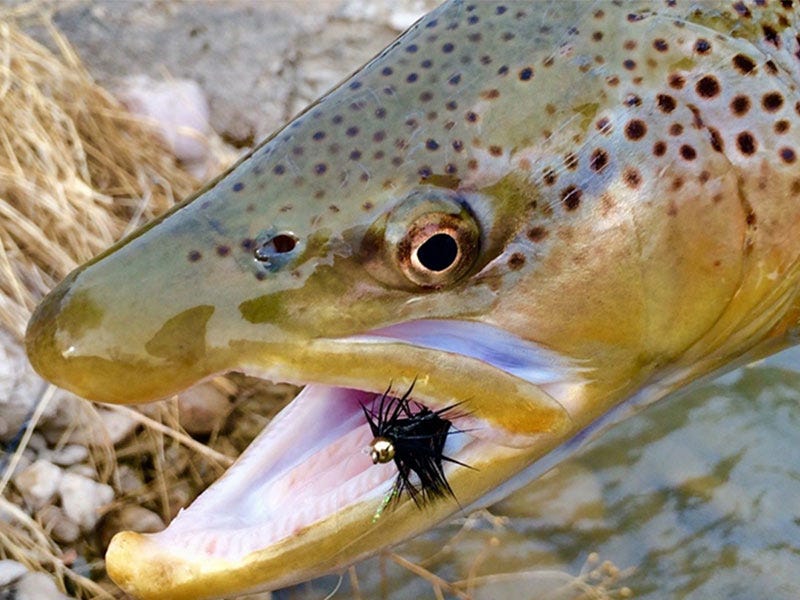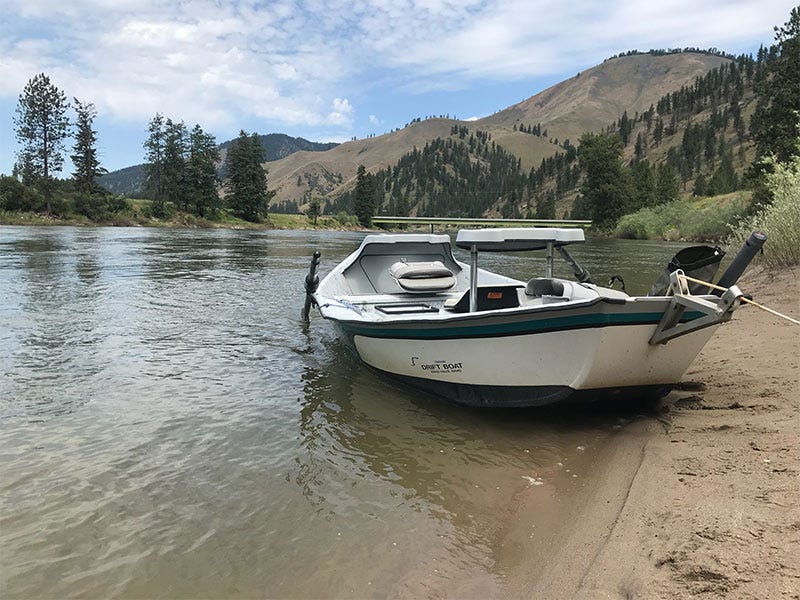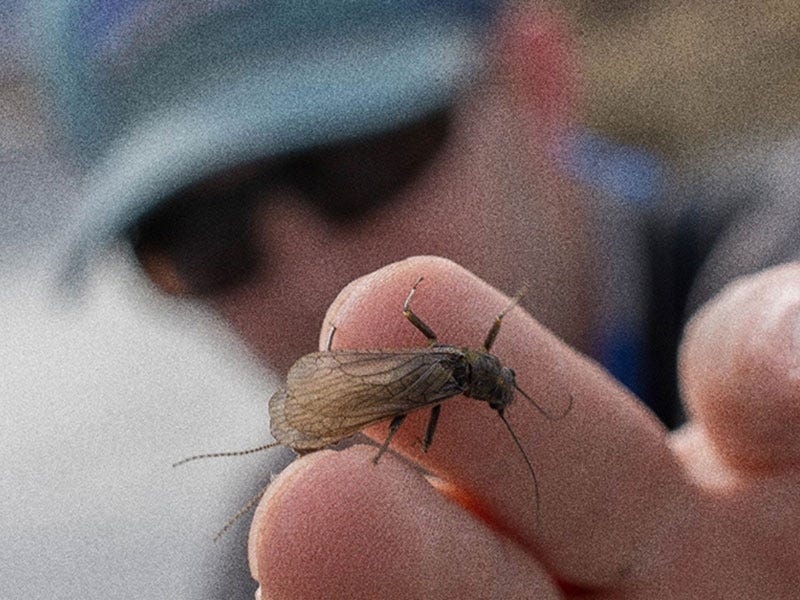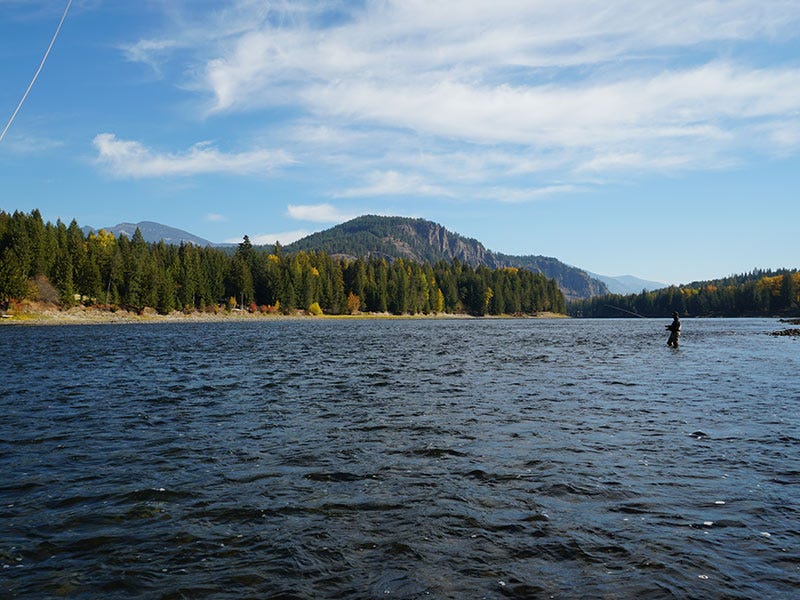Critical Spring Flies for the Clark Fork River

I have a super soft spot in my heart for springs on the Clark Fork River. When conditions are right, I wouldn't rather be anywhere else. It could be that the Clark Fork has bigger fish on average than the other rivers. Or, it could also be that they fight much harder too. Plus, the diversity in species is great. There is nothing like a 20-plus inch dime-bright rainbow busting out of the water and screaming out line down river. I really don't mind the occasional treat of a big hook-jawed brown either or a gorgeous native westslope cutthroat. I even love the gigantic whitefish we catch there too, they’ll put up darn near just as good of a fight as some of the other fish in the river.
Dry flies and big rainbows? Read our guide to the lower Clark Fork here.
What I want to go through is the fantastic variety of the critical flies we get on the Clark Fork in the spring. I have clichéd dreams of skwalas crawling all over me and my drift boat floating down the Clark Fork -all the while, dozens of toilet bowl rises engulfing skwalas or maybe a March brown or blue-winged olives too. This is truly a reality on the Clark Fork. When things align just right, it is heaven on earth. Dreams yes. Even better, it's right in my back door.
Critical Spring Flies for the Clark Fork River
Skwala Stonefly -be careful here. One dude whispers skwala over in Missoula or maybe on the Yakima in early March, and all of a sudden, it's time to go? This is not always the case. We really don’t see the main hatch until April -mostly mid-April, and it needs to be warmed up in the 50s too. Now, that doesn't mean you won't see them sooner than that but, not in great enough numbers to really get the fish keying in on them. The bigger issue to watch is the water flows.
Read current conditions from the CDA region here, or click here to view all northwest regional reports.
It can be a crapshoot whether the flows will be conducive or not to even fish the hatch. A few main factors need to come together to get good skwala fishing on the Clark Fork. One, temperatures need to be in the mid-50s for the better part of a week, the sun doesn't hurt either. Second, there needs to be decent flows, respectively around, or lower than, 12,000 cfs with a decent amount of clarity. It's an awesome hatch to hit though when it all comes together. We keep a great supply of patterns in our bins here at the fly shop, we have what you need. From foam, elk hair, to bullet heads and low riders, you name it we have them. This is an iconic hatch in our area and you’ll want to keep your ear to the ground in the spring and watch the conditions. If you can hit it right, it really is dream worthy.

Midges -this little guy is a rather under fished hatch on the Clark Fork. It isn't like the Missouri, here you hear of plague-like clouds of them balling up in the foam lines. The Clark Fork will get consistent hatches of midges starting in late February to early March. You can get a freak 50-degree sunny day in early March and, presto, killer midge fishing. It's rare though that this happens. Last year I had a couple of days over on the Clark Fork that were amazing midge fishing. It was high overcast with temperatures in the high 40s. Plus, there was no wind and it was on like Donkey Kong! There really never are big masses of midges there but plenty of them to get the fishes attention. They seem to be bigger too on average than other rivers for some reason. Using a size 16 is not out of the norm and, in the midge world, that is pretty big.
I hate having to string up a size 20 or for that matter an 18. This just really reduces your odds at landing big fish and or even hooking them. I tie a couple of patterns with rabbits’ foot for the wing and these work killer. The Griffith's gnat is a no brainer during this hatch. I'll fish them in tande to up my odds. The back eddies on the Clark Fork are great places to look for heads up sipping. You'll see big poufy clouds of foam in these eddies. The midges collect there, and you will see head to tail rises in the foam. We call this "sharking." In these situations, I also like to strip a couple of smaller soft hackles with quick short strips. It's like mini streamer fishing and can be very effective. Again, the midge hatch is rather underfished on the Clark Fork as it is usually pretty cold and blustery. I love it though. The odds of a blown-out river are much lower then and can be a very consistent hatch throughout all of the spring months too. Don't go to the Clark Fork without them!
Blue-Winged Olive Mayfly -alongside the midges in the spring, these little guys come out about just as early. When it happens, it really does have to be much warmer to get the big masses of them. When I say big masses, I mean it can be thick with them. The spring variety seem to be a bit bigger than the late summer ones. In the spring, they usually run in the 16s and in the fall more in the 18s down to 22s. The hatches become thicker in late March and April.
I've had somewhat confusing days on the Clark Fork. Seeing lines of fish up eating the tiny blue-winged olives floating right next to a March brown or even a skwala? Crazy right? I think so. For whatever reason, they will single out these over the other bugs. I just shake my head as I see a far higher source of protein floating by these fish, they couldn't care less. There is an old saying, "you cannot force feed a trout." No matter how bad you want to tie on that juicy new skwala you spent all winter crafting up. You better have Mr. Blue-winged olive right next to it.
Want to learn more about blue-winged olives? Read our hatch guide here.

March Brown Mayfly -Oh man! The March brown is like Robin and the skwala is like Batman. They run together through late March and April and throughout May if you are lucky to have water in shape. If the day holds cooler temperatures, where the skwalas are not flying but hanging on to the willow branches, the March browns will be popping off, and the trout will be gorging on them. We have a pretty common launch spot on the Clark Fork called Tamarack Creek. It is a midway point on a longer float from St. Regis downstream. I have fond memories of pulling into Tamarack Creek and chomping down on my sub sandwich watching these mayflies emerge only to have a great white-like attack trout annihilate it. I'd sit there watching these fish having a hay day eating these bugs but noticed the tops of the willows there holding dozens of cold skwalas. They are waiting for the sunshine to come out and dry off their wings and begin the life cycle all over again.
The magic really starts when the sun comes out and both bugs are on the water. How do you choose? That's a hard one. I like to run a skwala as my point fly and then a bigger soft hackle as a trailer fly. This will be mimicking a March brown emerger. Or, you can elect to run a March brown dun or cripple too. All should work fine. Just keep switching your back fly until you get success there and then you have the right recipe. If you are floating and having a tough time finding your smaller March brown in the choppy water, Mr. skwala point fly will help you to locate your back fly on the water, or god forbid get eaten too! This is a killer combo on the Clark Fork during these two hatches. It can be tough to choose what to throw so use both!
Need the right emerger pattern? Check these out.
Nemoura Stonefly -or, as some of the locals call them, "snow stones." These little slender jet-black stoneflies will come off as early as late February. You can see them crawling on the tops of the snow banks on a sunny day in late February throughout most of March. They are typically hatching on the banks and then the females will fly back to the river to lay eggs on the water. They are probably one of the smallest stoneflies we have here, next to the yellow sally stone. You'll see these guys coming off on sunny days amongst the midges and an occasional blue-winged olive.
A size 14 black stimulator or black x-caddis is a great pattern for this bug. These hatches can be thick. If the fish are really keying in on them, I'll run the black stimulator with a small black soft hackle dropper during this hatch. This is to see if they are keying in on the emergers. If this is the case, I will put two tandem soft hackles back to back and swing them at a down and across angle to the current. This is very similar to our caddis hatches in the summertime. Also, I’ll bump up my tippet size when doing this to a 3X variety. The takes can be vicious when swinging the soft hackles. I'll even go as far as pinching a drop loop in between my finger and my cork handle. When the fish grabs ahold of my fly, I try not to set and let the fish have the loop. Then boom! Fish on.

These are the main players on the Clark Fork from late February to May. This is spring to me on the Clark Fork. Come May and June, we are lucky to be fishing on the Clark Fork. This year, like last, we received a ton of snow. This is a good thing. We should have good flows throughout July and August when we desperately need water. Hopefully, we will get some rain too during the summer to quell the chances of fires. Again, it can be a coin toss for fishing in the spring. However, through the winter you should be stocking up on these flies, they are very important. Heck, if you are new to fly tying and want to come learn, we offer free fly tying through the winter months. This is a great way to learn the different hatches on our local waters. It pays to stay super in tune with the water flows from March through May. As there can be windows of goodness, not only goodness but maybe the best fishing of the year.

